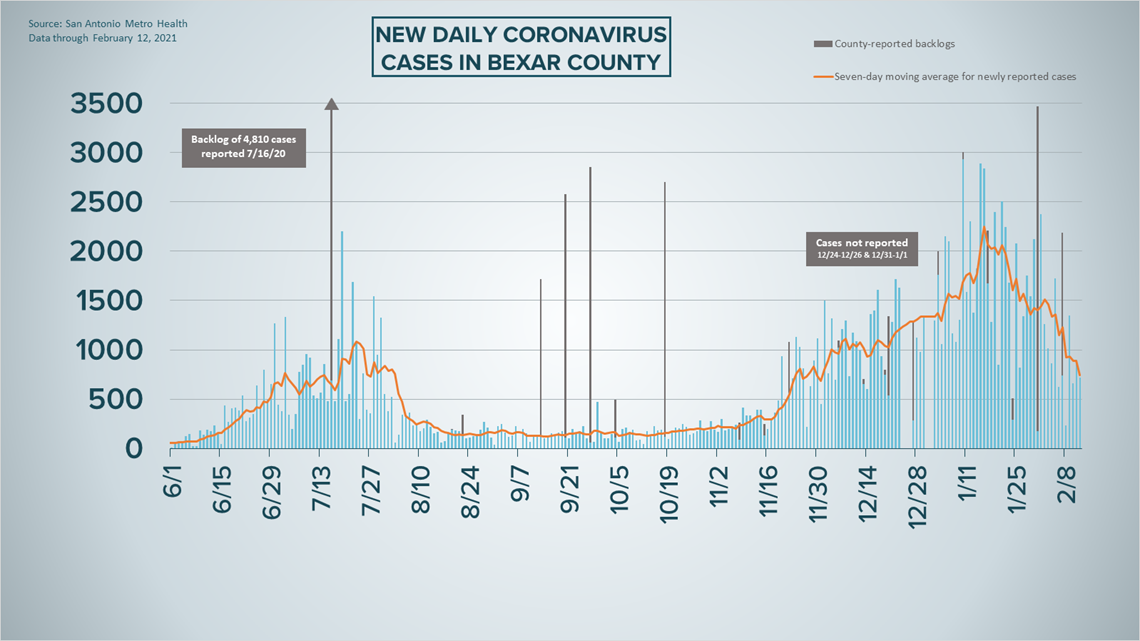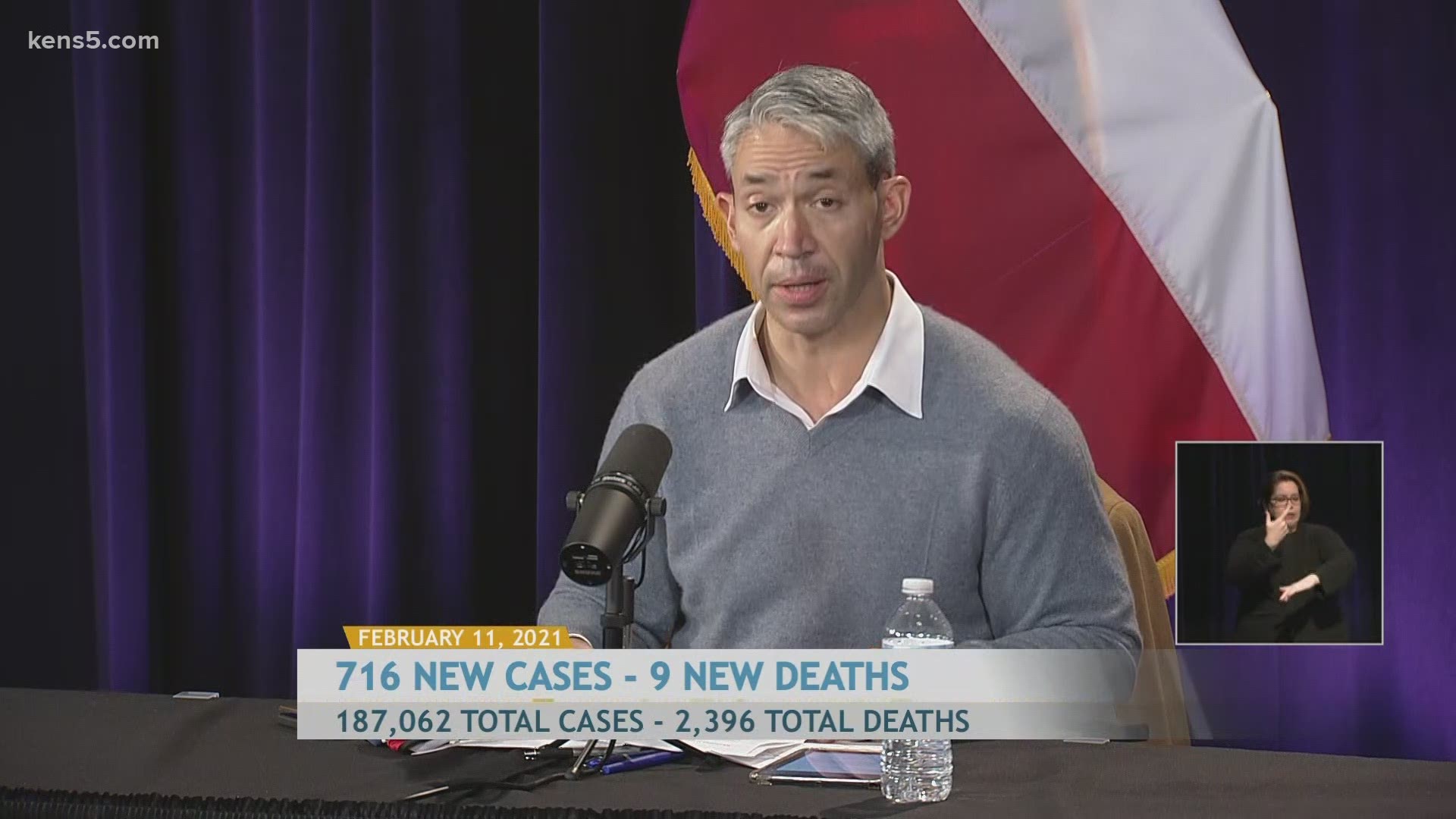SAN ANTONIO — We're tracking the latest numbers from the coronavirus pandemic in San Antonio and across Texas. Here are the latest numbers reported by Bexar and surrounding counties:
- Bexar County: On Friday, 716 new cases were reported, bringing the total number of cases to 187,062. Nine new deaths were also reported, raising the local death toll to 2,396.
- Hays County: On Friday, officials reported 45 new cases in the county and no additional COVID-related fatalities. As of Friday, there are a total of 15,837 lab-confirmed local cases, while the death toll remained at 202. Officials estimate 14,238 residents have recovered, while 1,397 are still ill with the virus.
- Comal County: On Friday, officials reported 65 new cases and no additional COVID-related fatalities. There are a total of 8,831 cases, including 4,650 confirmed and 4,163 probable cases, while 269 county residents have died due to COVID-19 complications. The county estimates 7,917 residents have recovered, while 645 are still ill with the virus.
More county case information is available through the Texas Department of Health Services COVID-19 dashboard.
How Bexar County is trending
We've tracked how many coronavirus cases have been confirmed in Bexar County from the time officials began reporting cases in March 2020. The graphic below shows the number of cases since June and charts those daily case numbers along a 7-day moving average to provide a more accurate picture of the overall coronavirus case curve in our area and the direction we're trending amid the pandemic.
On Friday, San Antonio Mayor Ron Nirenberg reported an additional 716 coronavirus cases in Bexar County, raising the local diagnosis total to 187,062 since the pandemic began. The seven-day average was slashed to 746, down from 890 on Thursday.
Nirenberg also reported nine more coronavirus-related deaths, including a pediatric death in the county. At least 2,396 Bexar County residents have died from virus complications.


As with the state at large, hospitalizations continue to go down in the San Antonio metro. On Friday, 767 patients were receiving treatment for their symptoms at area hospitals; that's down from 791 on Thursday.
Of those 767 patients, 164 are on ventilators and 306 are in ICU. Both of those figures are also down from Thursday's numbers.


Coronavirus in Texas
The total number of novel coronavirus cases in the state since the pandemic began grew by 12,502 on Friday, according to the Texas Department of State Health Services. That total includes 9,049 new confirmed cases, 2,322 new probable cases, and a backlog of 1,131. More details can be found on this page.
Friday's figures bring the total number of Texans diagnosed with COVID-19 to more than 2.541 million.


Meanwhile, state health authorities reported an additional 324 deaths from coronavirus complications in Texas. In all, 40,095 Texans have died from COVID-19.
Hospitalizations across the Lone Star State continue to plummet. The number of COVID-19 patients receiving treatment for their symptoms throughout Texas decreased by 326, to a current count of 8,607. That continues the positive downward trend for Texas that began in mid-January, and brings statewide hospitalizations down to their lowest levels since Nov. 28.
The state, meanwhile, estimates that about 2.204 million Texans have recovered, while 278,017 Texans remain ill with COVID-19.
The latest update from the Texas Education Agency showed that there have been at least 175,077 cumulative cases among staff and students on Texas public school campuses through Feb. 7. That number comprises 113,311 positive student cases and 61,766 staff cases. More information can be found here.
The TEA releases new data on school cases on Fridays.
Latest Coronavirus Headlines
- Nirenberg, Wolff pen letter to FEMA requesting additional mega vaccination site in Bexar Co.
- CDC releases long-awaited guidance on reopening schools
- Fauci: Masks will still be needed for 'several, several months'
- Memphis doctor believed to have died of rare COVID related syndrome
- NCAA finalizes COVID-19 safety protocols ahead of tournament in San Antonio
- VERIFY: Wear two masks and know the tricks to a snug fit to stop COVID-19
- US to have enough vaccine for 300 million Americans by summer, Biden announces
Coronavirus symptoms
The symptoms of coronavirus can be similar to the flu or a bad cold. Symptoms include fever or chills, cough, shortness of breath or difficulty breathing, fatigue, muscle or body aches, headache, new loss of taste or smell sore throat, congestion or runny nose, nausea or vomiting, and diarrhea, according to the Centers for Disease Control.
Most healthy people will have mild symptoms. A study of more than 72,000 patients by the Centers for Disease Control in China showed 80 percent of the cases there were mild.
But infections can cause pneumonia, severe acute respiratory syndrome, kidney failure, and even death, according to the World Health Organization. Older people with underlying health conditions are most at risk.
Experts determined there was consistent evidence these conditions increase a person's risk, regardless of age:
- Chronic kidney disease
- COPD (chronic obstructive pulmonary disease)
- Obesity (BMI of 30 or higher)
- Immunocompromised state (weakened immune system) from solid organ transplant
- Serious heart conditions, such as heart failure, coronary artery disease, or cardiomyopathies
- Sickle cell disease
- Type 2 diabetes
The CDC believes symptoms may appear anywhere from two to 14 days after being exposed.
Human coronaviruses are usually spread...
- Between people who are in close contact with one another (within about 6 feet).
- Through respiratory droplets produced when an infected person coughs, sneezes or talks. These droplets can land in the mouths or noses of people who are nearby or possibly be inhaled into the lungs.
- Some recent studies have suggested that COVID-19 may be spread by people who are not showing symptoms.
Help stop the spread of coronavirus
- Stay home when you are sick.
- Eat and sleep separately from your family members
- Use different utensils and dishes
- Cover your cough or sneeze with your arm, not your hand.
- If you use a tissue, throw it in the trash.
Find a Testing Location
City officials recommend getting a COVID-19 test if you experience fever or chills, cough, shortness of breath or difficulty breathing, fatigue, muscle or body aches, headache, new loss of taste or smell, sore throat, congestion or runny nose, nausea or vomiting, or diarrhea.
San Antonio operates several no-cost testing locations, including two walk-up locations open Monday-Sunday from 10 a.m. until 2 p.m.:
Cuellar Community Center
5626 San Fernando St.
San Antonio, TX 78237
Ramirez Community Center
1011 Gillette Blvd.
San Antonio, TX 78224
Additionally, Freeman Coliseum offers drive-through no-cost testing from Monday through Sunday between 9 a.m. and 4 p.m. An appointment is required and can be made either online or by calling (833) 213-0643.
Here's a Testing Sites Locator to help you find the testing location closest to you in San Antonio.

